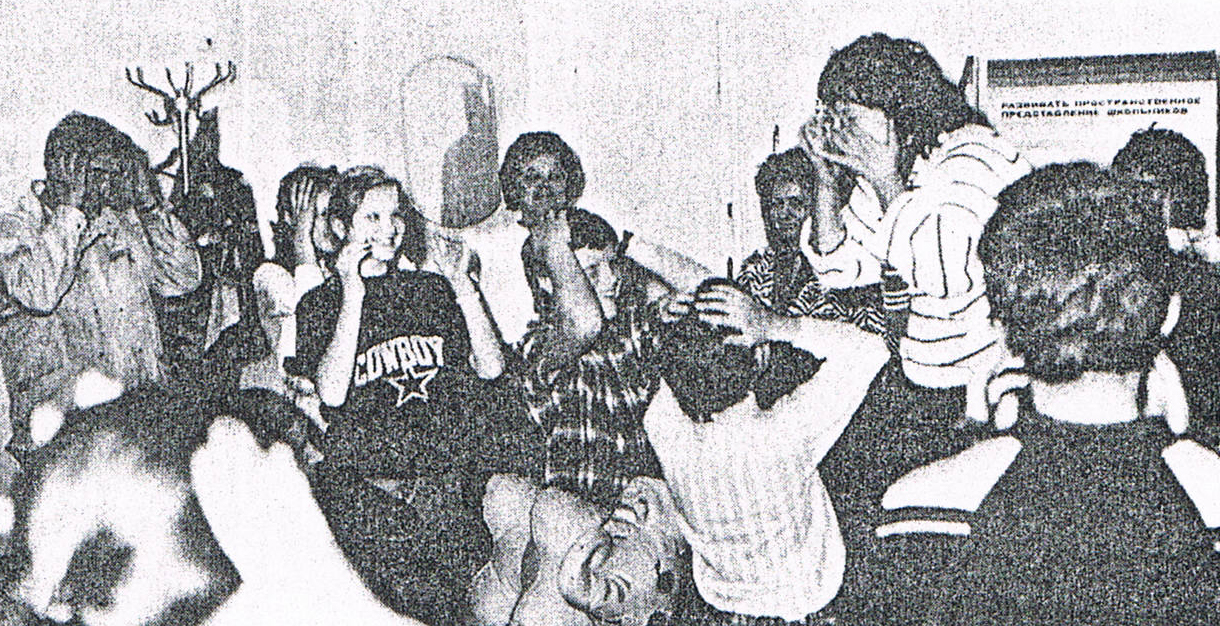Ãëàâíàÿ
Îá ýòîì ñàéòå
Íåìíîãî î ñåáå
Ñòèõè
Êíèãè
Îäíà ïüåñà
Ñêàçî÷íûé àíãëèéñêèé
Âûñòóïëåíèÿ
Èíòåðâüþ
Äëÿ ãàçåò1990 A story about storytelling
1991 Over here
1991 How to tell tall stories
1991 Empty shelves and English
1992 Storytelling in practice
1996 "- Çàêðîéòå çà ìíîé ðîò!"
1997 "- Âû îáîçâàëè ìåíÿ ïîýòåññîé?"
1998 "-ß âñåõ ëþáëþ, è ìíå âñåõ î÷åíü æàëêî"
1999 Î Ðåíàòå, Ìóõàðìñå è ïëàòêå õîáîòîâîì
2004 Ðåíàòà Ìóõà: íà÷àëî ñëåäóåò..
2005 Ïòè÷üè ïðàâà: ïðûãíóòü ñ ïàðàøþòîì ââåðõ...
Íà òåëåâèäåíèè
Íà ðàäèî
×òî áûëî â ãàçåòàõ
Ãëàçàìè äðóçåé

Renata Tkachenko STORYTELLING IN PRACTICE Renata Tkachenko, Assistant Professor in the English Department of Kharkov University, Ukraine, USSR, Ðóññêèé ïåðåâîä ÷èòàòü çäåñü. The Elephant Child An interactive process A word of warning EFL Gazette, May 1991
offers “some observations from a non-native storyteller”
Over the last decade or so, there has been an increasing interest in the use of storytelling to teach language. The educational potential of storytelling, its emotional, aesthetic, cultural and social advantages have been discussed by Rosen, Blair, Morgan & Rinvolucri, Garvie, Garvie, Ellis & Brewster, to mention but a few. Particular interest in storytelling has been shown by non-native language teachers, as this method of natural language acquisition compensates to some degree for the absence of a natural communicative situation outside the community of native speakers.

However, storytelling presents one problem to a teacher trainer whose interest is not only telling stories, but helping others to tell them. Descriptions of procedures, comparisons of results, discussions of lesson plans do not really help to convey to colleagues the specific appeal of this method unless they have actually seen an example of a storytelling session and, better still, participated in it. For this reason, I decided to include in this article part of a transcript of a lesson in a Russian school.
The children had been doing English two or three times a week for about six terms. The story told was an “oral” version of an extract from Kipling’s The Elephant Child, the charming tale that, “once upon a time”, actually started me on storytelling.
The children were allowed to use their native language, but the storytelling herself managed to avoid using Russian. She was helped in that by mime, gesture, visuals, but above all, by her enthusiasm and the growing enthusiasm of the audience. The abbreviation used in the script are: (g) – gesture; (m) – mime; (ch) – children speaking.
(a transcript of a lesson)
“Well, children, I’m going to tell you one of my favourite tales today. Can you guess what it’s about? No, it’s not about a king. And not about a queen. It isn’t about a person at all. A cat? No, it’s a tale about a much bigger animal. Why a dog? Is a dog much bigger than a cat? And not about a horse either – bigger still. I think I’ll have to help you. My animal has big ears, a short tail and a very long… stop that shouting, please. But you’ve guessed right. My fairy-tale is about an elephant. Only the elephant hasn’t got a nose, he has a trunk – but I must tell you that in our tale, at the beginning of the story, the elephant has a nose. He gets a trunk only at the end. Why? That’s just what the fairy-tale is about, and we are going to tell it together. Are you ready? No, you’re not. What do we always do when a fairy-tale begins? That’s right. We sit comfortably, we put our fingers on our lips and we say, “Shhh”. Now we can begin and we’ll begin together, because we know – don’t we? – how English fairytales begin.”
This pre-story part of the lesson helped the teacher to get the children interested, to establish a rapport with her audience, to prepare them for active participation in the next stage - storytelling proper. While this was in progress, the listeners and viewers became active participants and, in later stages, characters and narrators of the story. To achieve this, the teacher quite often had to digress from the story line to ask questions, give commands, make suggestions and use other ways of involving the audience.
The story
Once… (ch), good, once upon a time, the Elephant had no trunk. He only had a blackish, flat nose (g), as big as a boot, (m) an elephant's boot, not yours! That’s more like it. He could move his nose from side to side (m) – like this – you see, we can do it too – but he couldn’t pick things up with it (m). Have we come across this expression “pick up”? Good girl, Lena, that’s right, the dog in our last story about the lost slipper did what? He tried to pick the slipper up when he saw it lying in the puddle. So, again, the Elephant could move his nose from side to side (m), but he couldn’t pick things up with it.
Do you like our story so far? You do? Good, then we’ll go on.
But there was another Elephant, a new Elephant – The Elephant’s Child, and he was full of curiosity. I know that “curiosity” is a new word, but perhaps you’ll guess what it means when you hear the next sentence. Here it is: He asked so many questions. Does that help? Can anyone guess? … Well done, Dima, that was a difficult word, wasn’t it? Let’s say this sentence together. Now, just the boys. And the girls. Very good. I hope you’ll remember this word. We are going to use it very soon.
Right, the Elephant’s Child lived… where do you think he lived?... (ch) In Africa, certainly, where else? He lived in Africa and he filled all Africa with his … our new word, please … (ch), very good, with his curiosity.”
Some of the techniques that can help the storytelling to keep the interest of the audience alive during listening include:
- the use of guess-work
- encouraging the listeners to predict
- referring to stories told before
- working out the meaning of words from their context
- challenging the listeners (“I told you you’d never guess what he did, didn’t I?”)
- encouraging the listeners to express their opinions and attitudes
- practicing different techniques of repetition (individual; in pairs / groups; “expressive”, e.g. say it softly, angrily)
- building up a repertoire of fixed gestures that can serve as a “visual” dictionary
- establishing a special storytelling routine
- using a lot of praise and hardly any criticism
For native speakers of the language, the skills of storytelling will probably come naturally. But for non-native teachers, all those Can you guess?, What do you think?, techniques present more challenge, partly because of the unpredictability of the learners’ responses and partly because of the lack of materials that actually show what is happening in storytelling sessions and in what ways the written story differs from its “storytelling” version. For this reason, I offer phrases that could be used. There came from three main sources: observation in classrooms, transcripts of lessons and collections of stories to tell. The list is far from being exhaustive but I hope it will provide a guide for non-native teachers and will help them to feel confident and relaxed during their sessions.
An interactive process
Shall I tell you a story?
Right, here is a story about how the elephant got his trunk.
This is how the story begins:
Choosing a story to tell
We need to agree on the story we are going to tell.
Which do you want, a story about a tiger or a story about a cat?
Who are the characters going to be?
Where is our story going to be set?
Seating the pupils
Come here and make a circle around me.
Could you turn your chairs this way?
Will you be all right there?
Encouraging the pupils to join in
Don’t you want to help me tell this story?
The whole class, please.
Everyone!
Just the boys/girls please.
Different ways of involving the listeners
You’ll never guess what happened next!
Guess what?
What do you think happened next?
And then do you know what she did?
Storytelling offers vast opportunities for reinforcing grammar and vocabulary, and the temptation to digress from the story for the sake of these didactic purposes can be great. It is, however, my conviction that the most important thing about storytelling is the story itself, and digressing too often, too far and too long may kill the story and with it, to quote Robert Blair the “real, heart-felt functional communication in a foreign language”, which is the main advantage and appeal of this enchanting, rewarding and challenging teaching activity.
References
Blair, Robert W Stories and Storytelling in First-level Language-learning in Per Liguam Vol. 1 No. 2
Elis, Gail & Brewster, Jean The Storytelling Handbook for Primary Teachers, Penguin
Garvie, Eddi Stories as Vehicle Multilingual Matters Ltd
Morgan, John & Rinvolucri, Mario Once Upon a time CUP
Rosen, Betty And None of it Was Nonsense Mary Glazgow
Tkachenko, Renata A story about Storytelling ELT Review No.2, 1990 (British Coucil)
*More about criteria for selecting stories can be found in my article in ELT Review No.2, 1990.
Modern English Teacher, volume 1, number 2, april 1992
